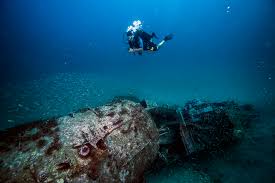17th Apr 2024
Wreck Diving Guide 101: Exploring the Depths of Maritime History
For many scuba divers, exploring shipwrecks is the pinnacle of underwater adventure. These submerged relics offer a glimpse into history, often teeming with marine life and surrounded by an aura of mystery and intrigue. However, wreck diving requires careful planning, specialized equipment, and a thorough understanding of safety procedures. In this comprehensive guide, we'll delve into the essentials of wreck diving, from choosing the right site to navigating through underwater mazes.

Choosing the Right Wreck
Before embarking on a wreck diving expedition, it's essential to research and select suitable dive sites. Consider factors such as depth, visibility, current strength, and the condition of the wreck. Novice wreck divers should start with shallow, well-preserved wrecks with minimal hazards. As experience and skills develop, divers can progress to deeper and more challenging sites.
Safety First
Safety should always be the top priority when wreck diving. Conduct thorough pre-dive checks on equipment, including regulators, dive computers, and underwater lights. Ensure that all gear is properly maintained and functioning correctly. Additionally, maintain proper buoyancy control throughout the dive to avoid accidental contact with delicate structures or marine life.
Navigation Techniques
Navigating through a shipwreck can be akin to traversing a maze underwater. Proper navigation skills are crucial to avoid getting lost and safely explore the wreck. Utilize a compass or rely on pre-established guidelines laid by dive guides to maintain orientation within the wreck. Pay close attention to entry and exit points, and establish a plan for communication with dive buddies.
Respect the Wreck
Wrecks are not only historical artifacts but also delicate ecosystems teeming with marine life. Exercise caution to avoid disturbing sediment or damaging fragile structures. Refrain from removing artifacts or souvenirs from wreck sites, as this can disrupt the ecosystem and diminish the experience for future divers. Remember to take only photographs and leave only bubbles.
Underwater Photography
Capturing the beauty of wreck dives through photography can be immensely rewarding. Invest in a quality underwater camera and familiarize yourself with its operation before diving. Experiment with different lighting techniques to enhance visibility and capture stunning images of marine life and intricate wreck details. Exercise patience and practice to master the art of underwater photography.
Advanced Training and Certification
For divers looking to delve deeper into wreck exploration, advanced training and certification courses are available. These courses cover topics such as wreck penetration, specialized equipment usage, and advanced navigation techniques. Undertaking formal training ensures that divers are equipped with the skills and knowledge necessary to safely navigate complex wreck environments.
Environmental Conservation
Preserving wreck sites for future generations requires active participation in environmental conservation efforts. Support organizations dedicated to marine conservation and participate in beach clean-up initiatives to mitigate pollution in coastal areas. Respect marine life and their habitats, and advocate for responsible diving practices within the diving community.
Conclusion
Wreck diving offers a unique opportunity to explore the hidden treasures of maritime history beneath the ocean's surface. However, it requires careful planning, adherence to safety protocols, and a deep respect for the underwater environment. By following this guide and embracing a mindset of conservation and exploration, divers can embark on unforgettable journeys into the depths of maritime history. So, gear up, dive in, and uncover the mysteries that lie waiting beneath the waves.
